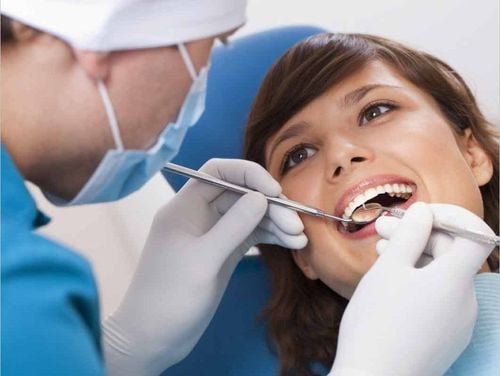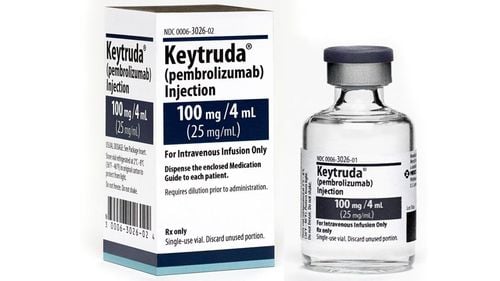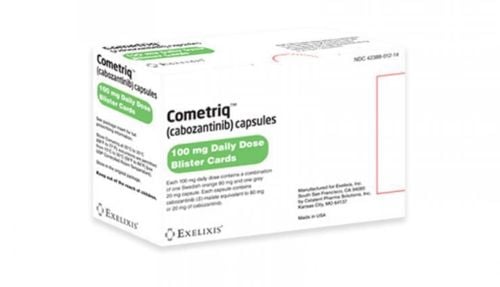This is an automatically translated article.
The article is professionally consulted by doctors working at Oncology Center - Vinmec Central Park International General HospitalSaliva is needed for swallowing and speaking, helps prevent infections and tooth decay, by cleaning teeth and gums and preventing too much acid in the mouth. Changes in saliva quantity and quality due to radiation have also been documented in the dental literature.
Symptoms of dry mouth during radiation therapy
Thick, spinning saliva Increased thirst Changes in appetite, decreased swallowing or speaking Feelings of pain or heat Chapping in the lips or corners of the mouth Changes in the surface of the tongue. Avoid wearing dentures. Up to 64% of patients treated with classical radiotherapy still show moderate to severe permanent lip dryness when evaluated up to 22 years after radiation therapy. Measures to reduce the severity of dry mouth are:Shielding devices can be made to protect the other side during unilateral radiotherapy Need to improve radiotherapy techniques (using radiotherapy techniques) intensity-modulating therapy (IMRT) Patients should be encouraged to drink enough water and stay hydrated to prevent oral infections Tongue should be cleaned 2 or 3 times daily with sodium bicarbonate solution Avoid sticky foods such as chocolate and cakes. Avoid caffeine containing strong drinks, alcohol or flavors. Sugar-free candies, gums and mints should be avoided. Salivary stimulants pilocarpine, anethole trithione, and cevimeline work by stimulating the activity of salivary gland tissue Antifungal drugs such as nystatin powder and clotrimazole can be used to treat infections.
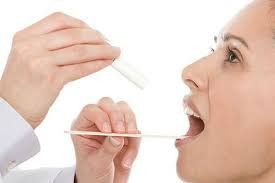
Khô miệng khi xạ trị
Tooth decay during radiation therapy
The risk of caries is increased secondary to a number of factors including a transition to the caries-causing flora, decreased concentrations of salivary antimicrobial proteins, and loss of mineralized components. One of the most effective methods of treating this condition is through the use of topical fluoride. Both sodium fluoride and zinc have been used in various forms with considerable success.After standard radiotherapy, there was a profound change in the oral microbiota with an increase in acidogenic bacteria, mainly Streptococcus mutans and Lactobacilli, coinciding with a decrease in the salivary system and an increased risk of caries. Dental caries in irradiated patients can develop rapidly as soon as 3 months after radiation therapy.
Prevention of dry mouth and tooth decay during radiation therapy:
Rigorous daily oral hygiene including fluoride and tartar removal has been shown to prevent the development of caries Chlorhexidine gel has also been clinically proven to reduce the risk of tooth decay Choose a diet without Contains alcohol to ease discomfort in people with dry mouthTightness of the jaw (Trismus) and fibrosis (FIBROSIS) of the jaw muscles
Jaw Tightening (TRISMUS) can be started soon after radiation therapy. Patients with tumors of the palate, nasopharynx, and maxillary sinuses are more likely to have cleft palate. If left unmanaged, cleft palate makes eating and swallowing difficult and various clinical dental measures virtually impossible.Cleft palate can be a significant side effect of radiation therapy especially if the sphenoid muscles are in the projection field. In patients where the sphenoid muscle was irradiated and not the temporomandibular joint, 31% exhibited trismus. In addition, radiation therapy to the temporomandibular joint is also associated with limited maximal mouth opening. Limited mouth opening can interfere with proper oral hygiene and dental treatment. Mouth balls can be used to gradually increase the opening of the jaw. Dynamic bite opening appliances are also used. The main mainstay of treatment is basically performing oral muscle exercises.
Management of oral complications during radiation therapy for head and neck cancer
The long-term effects are due to vascular and cellular changes of soft tissue and bone, damage to the salivary glands and increased collagen synthesis, leading to a decrease in blood pressure and hypoxia of tissues. Common chronic complications are dry mouth (xerostomia), dental changes, tooth decay, demineralization, change or loss of taste (dysgeusia), secondary infection (eg, candidiasis). Ulcers of the oral cavity (soft tissue necrosis). Osteoarthritis, pain, temporomandibular joint disease, cleft palate, nutritional deficiencies, psychological effects.... To a considerable extent, radiation-related dental problems can be prevented or minimized. by optimal management of complications.Dry mouth Ionizing radiation damages salivary gland tissue, leading to a rapid loss of salivary function. Salivary glands are particularly sensitive to radiation and respond acutely and chronically to radiation therapy. Of all the salivary glands, the parotid gland is mainly affected because the serous cells are the most sensitive. With loss of saliva, dry mouth or xerostomia, is the main symptom. The patient may become uncomfortable because there is no saliva to lubricate, and the mucosal tissues will become sticky. Individuals often complain of difficulty swallowing, food sticking to their teeth, and a burning sensation when eating spicy foods. Therefore, there may be changes in eating patterns with reduced nutrient intake and weight loss. Dry mucous membranes may also be more prone to bleeding, leading to bleeding gums.
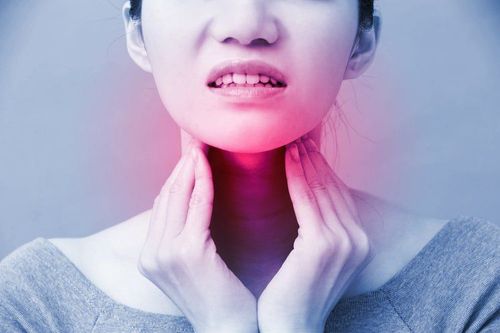
Khó nuốt
Histatins, a family of salivary proteins, have potent antifungal properties that inhibit the growth of oral thrush. The salivary glands also secrete immunoglobulins A and M that are particularly active against bacteria that cause tooth decay
Trismus and fibrosis increase in severity over time. This condition will only improve with continuous exercise.
Training should be done at regular intervals, after a period of rest. The more frequent and careful with the training regimen, the more beneficial the results. Chronic stiffness of the jaw gradually turns into fibrosis of the muscles and at the end of this process stretching is not considered an appropriate exercise solution. Exercise must begin early.
Malnutrition
Head and neck cancer patients at high risk for malnutrition may lose the desire to eat because of mouth pain, difficulty swallowing or dry mouth. When eating causes discomfort or pain, the patient's quality of life and nutrition are affected.
Nutritional support may include liquid diet and tube feeding High-protein, high-energy fluids to meet patient needs Intravenous infusion of additional nutrients. Swallowing problems are managed by the following team of specialists: Speech therapy; Nutritionist; Dental specialist; Psychologists... Radiation Necrosis of the Jaw (ORN) Radiation Necrosis is a condition in which bone dies in the area of radiation injury. ORN can be idiopathic but is most commonly associated with conditions such as hypotension, hypocalcemia, and bone hypoxia. This means that ORN can reduce cell formation and collagen synthesis in a post-radiation bone setting. If there is soft tissue breakdown, the bone will come into contact with the saliva and secondary infection will occur.
Fungal infections can also be caused by tooth extraction or surgery creating a more invasive form. This progression can cause severe pain or fracture due to hypoxia, damage to blood vessels, and hypotension, where tissue breakdown exceeds the repair capacity of injured tissues. Clinically, the initial ORN may be subgingival and mucosal bone breakdown. This process is self-limiting because the damaged bones are isolated and then cured and require deep surgery.
The reported ORN rate ranges from 0.92% of all head and neck cancer patients receiving radiation therapy.
Sulaiman et al evaluated the records of 1194 patients for the period 1998-2001. The follow-up period was 22.9 months. They reported that tooth removal before radiotherapy reduced the risk of necrosis in periodontal disease, especially the mandible, and its association with erosive ulcers.
This complication can be minimized if intensity modulated radiation therapy (IMRT) is used for head and neck cancer. This reduction is due to parotid gland preservation and better dental treatment, reduced number of tooth extractions and surgical procedures
After standard radiotherapy, there is a change in oral microbiota with reduced salivary flow, which can cause tooth decay.
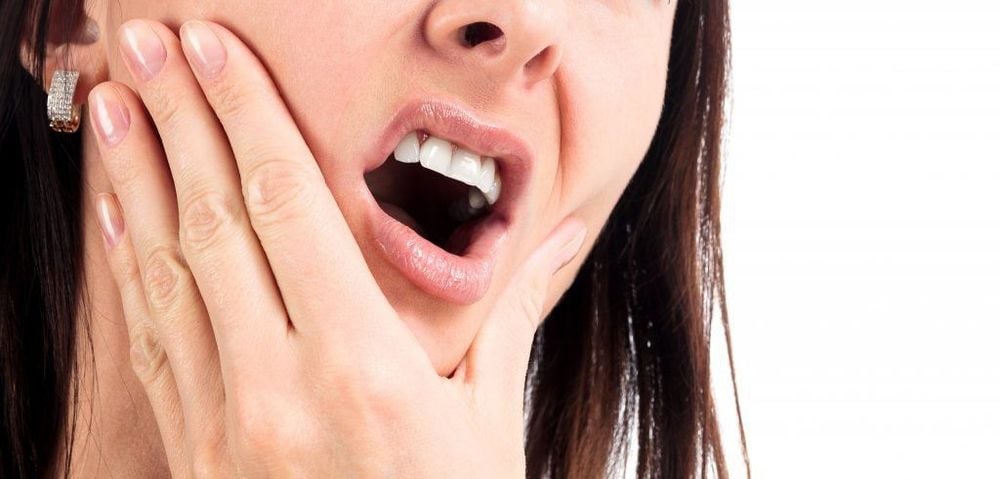
Nên làm gì để ngừa sâu răng?
Prevention and treatment of tooth decay
A rigorous regimen of daily oral hygiene that includes fluoride and the removal of dental plaque has been shown to prevent the development of tooth decay. Topical fluoride or chlorhexidine can reduce levels of S. mutans but not Lactobacilli. Because of the potential for adverse drug interactions, fluoride and chlorhexidine should be administered several hours apart.Vissink et al concluded that a lifelong commitment to improving oral hygiene and home care should include meticulous oral hygiene and self-application of fluoride or the 1% neutral sodium fluoride gel used. use at least every day. Daily use of 4% stannous fluoride may also be effective.
To learn more about radiation therapy for head and neck cancer at Vinmec, you can contact HOTLINE: 0938 506 009 or register online HERE.
Invite readers to refer to the rest of the Oral Care Manual in Radiation Therapy for Head and Neck Cancer:
In April & May 2021, when there is a need for head and neck cancer examination and treatment at Vinmec Central Park International General Hospital, customers will enjoy double incentives:
- Free specialist examination and 50% discount on many cancer screening packages
- 50% discount on costs for customers who have a prescription for post-examination treatment. The program is limited to the corresponding technique of each hospital and to customers who perform this treatment technique for the first time at Vinmec.
Please dial HOTLINE for more information or register for an appointment HERE. Download MyVinmec app to make appointments faster and to manage your bookings easily.





